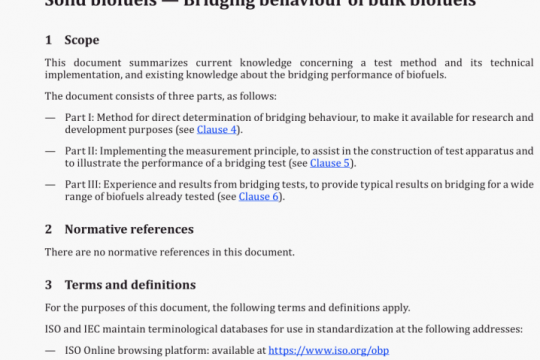ISO 11007-1 pdf free download
ISO 11007-1-2021 pdf free download.Petroleum products and lubricants – Determination of rust-prevention characteristics of lubricating greases – Part 1: Dynamic wet conditions.
7.3 Test fluid, use one ofthe following types:
a) water conforming to grade 2 of ISO 3696, or
b) synthetic sea water conforming to the specification given in ISO 7120, or
c) a 0,5 mol/1 solution of sodium chloride prepared using water conforming to grade 2 of ISO 3696, at a pH of8,O to 8,2, by titration with sodium hydroxide solution.
NOTE Water quality of water used as a test fluid is critical and therefore is a different grade from that specified in 72.
Other water types may be used in this test, although the precision when using other water types has not been determined. It is recommended that the pH of other water types is determined before use.
7.4 Propan-2-ol.
7.5 Ammonia solution, 3,2 % (rn/rn) (1,65 mol/1).
NOTE The ammonia solution is equivalent to a tenfold dilution of 35 % ammonia solution (p = 880 kg/rn3) with water conforming to grade 3 of ISO 3696. This ammonia concentration is critical to the results of the test.
7.6 Solvent rinse solution, consisting of nine volumes of propan-2-ol (ZA) mixed with one volume of ammonia solution (Z).
7.7 Silver nitrate solution, 0,1 mol/l.
8 Preparation of the apparatus
8.1 Remove all traces of grease from previous tests by wiping the plummer blocks housing (see ALl).
Wash the plummer blocks housing and all other parts in solvent rinse solution (Z) followed by water
(72). Dry thoroughly using a cloth (1).
Where previous tests have been carried out with either synthetic sea water [Z3.b)] or salt water [Z3.c)], pour a few drops of silver nitrate solution (7J) into the plummer-block. Withdraw a sample of the silver nitrate solution using a clean pipette, and inspect for milkiness or a white precipitate. If a white precipitate appears, rinse the plummer-block with hot water (72) and repeat this washing until a withdrawn sample is clear.
8.2 Wear protective gloves (±a) or use tweezers (4) for all subsequent handling. Do not touch the bearings with bare fingers. Use two new bearings for each test.
8.3 Number the bearings on the outside diameter of the outer ring but do not use acid etching. A “vibro pen” or etching marker may be used.
8.4 Wash the bearings in wash solvent (iLl) at 50 °C to 65 °C, to remove the rust-preventative.
Repeat the wash using fresh portions of hot wash solvent until the rust-preventative has been completely removed. In cases of dispute, white spirit (see NOTE to 7.i) is the referee solvent.
IMPORTANT — The complete removal of the rust-preventative is critical to the precision of this method. Failure to remove the material wholly will invalidate results.
8.5 Transfer the bearings from the wash solvent to the solvent rinse solution (Z) to remove any solvent remaining. Rinse the bearings and rotate the outer ring slowly relative to the inner ring, while the bearing is immersed in freshly made solvent rinse solution heated to a minimum of 65 °C.
pyright Intefnatio1aI rzii rights reserved 3
ISO 11007-1:2021(E)
CAUTION — The washing temperatures specified are significantly higher than the closed flash point of the solvent. Therefore, carry out the washing operations in a well-ventilated hood where no flames or other ignition sources are present.
8.6 Remove the bearings from the solvent rinse solution and place on a filter paper (9) or cloth (i} to drain thoroughly. Place the bearings in the oven (i) until they are completely dry. This requires a minimum of 15 mm.
8.7 Remove the bearings from the oven and allow cooling to ambient temperature. Examine the surfaces to ensure that each bearing is corrosion-free and free-turning.
WARNING — Take care not to spin the bearings after cleaning and drying.
8.8 Inspect the outer ring tracks using a dentist’s mirror (BA). If etch spots or corrosion are evident,reject the bearing.ISO 11007-1 pdf download.




